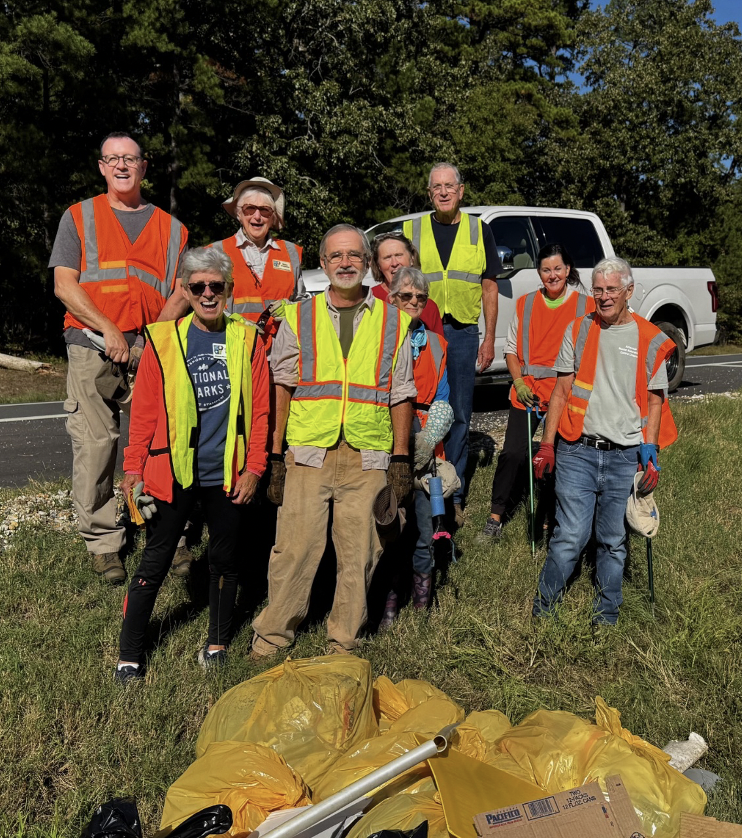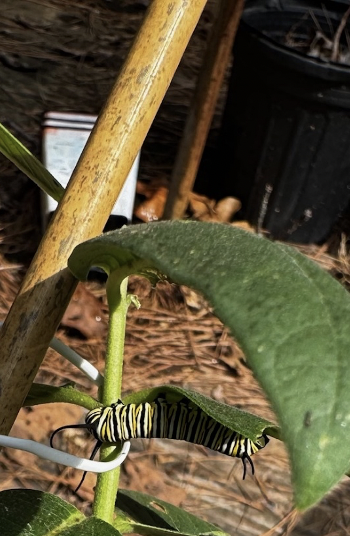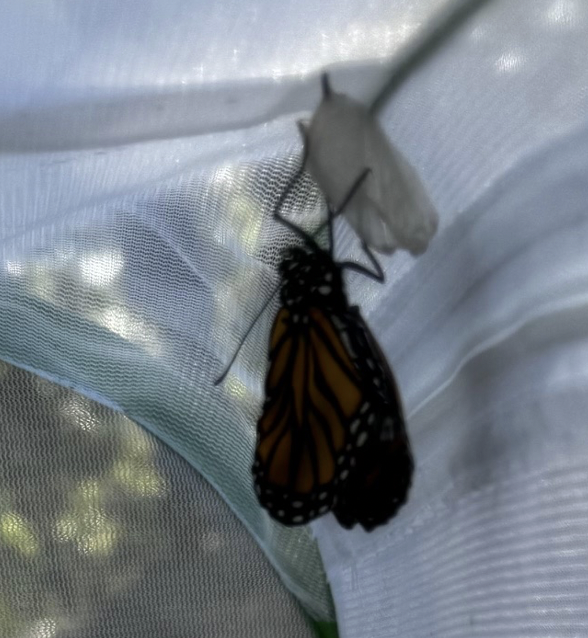|
CAMN MONTHLY NEWSLETTER
October, 2025 | | |
CAMN General Meeting
Thursday, October 16, 2025
Audrey Cobb & Kate Spontak will be leading a screening & discussion of The Nature of Oaks by Doug Tallamy
Location: Witt Stephens Jr. Central Arkansas Nature Center
602 President Clinton Ave.
Little Rock, AR 72201
Time: 6:00 PM until 8:00 PM
Pizza at 6:00. $1.00/slice
Program 6:30--7:30. Counts as 2 hrs CE in person. Zoom available 1 hr CE.
|
Attend this screening to hear Doug Tallamy reveal the essential role oak trees play in supporting biodiversity and explain how they sustain wildlife and healthy ecosystems.
The recorded webinar is about 50 minutes long. Afterward, we will have a Q&A and discussion. If you are already familiar with Doug Tallamy's work, spread the word.
| | CAMN Plants Over 300 Arkansas Native Perennials at PMSP
By Bill Toland
Over the last two weeks the CAMN PMSP native plant crew planted over 300 Arkansas native perennials in the park confines.
This included the memorial in the Arboretum, the lower mountain bike parking lot, the GH garden, the new visitor center, and the two park entrance signs.
Kay Sanders, Denise Ragland ( Steve),Mona Churchwell, Sue Powell, Katie Sakevicius, Frank Olinde, Cindy Hancock, and Bill Toland all confirmed that it was backbreaking work.
| | | We’ll be rewarded with blooms next year in addition to providing various nutrients for our pollinators and beneficial insects. |  |
Highway 300 Pickup Team Cleans Up
By Lynn Foster
This month the intrepid Highway 300 Pickup Team cleaned CAMN’s mile of Highway 300, between Highway 10 and the Valero gas station south of Pinnacle Mountain State Park. As usual, there were enough volunteers so we could also clean a short (but very trashy) stretch of Chenal Parkway, bordered by woods, just south of Highway 300.
The master naturalists collected 21 bags of trash, including a large furniture cushion and many collapsed boxes that someone had been sleeping on. Most interesting find: a Timex watch with a leather band, found by Diane Brownlee. Most interesting roadside plant: a single Whorled Milkweed, complete with aphids.
We dedicated this pickup to Nancy Deckard, who faithfully coordinated the pickup and also worked on it for many years. If you’re reading this out in Washington State, hello Nancy!
Thank you, team members:
Diane Bradlee
Paul Gosnell
LaRue Jolly
Roy Mellor
Kay Sanders
Lee Soderberg
Bill Toland
Nancy Wyatt
Carole Yeung
Pickup dates are posted in CAMN emails once they are set. If the weather stays warm, our next pickup may be in December.
Pictured above: The Highway 300 Team
| | Beer, Brats, and Bluebirds scheduled for Saturday, October 25
It’s time again for our annual Beer, Brats, and Bluebirds at
Pinnacle Mountain State Park on Saturday, October 25.
We’ll survey and clean out about 50 Bluebird boxes to get them ready
for the next nesting season. Some may be replaced or added.
Teams will be assigned a certain group of boxes to check out.
| | |
Sometimes conditions can be muddy and wet, so come prepared.
Hiking involved.
Afterward grilled brats and beer will be available.
We’ll meet at PMSP greenhouse at 14205 Pinnacle Valley Rd.
We’ll have a short Bluebird orientation at 9:30 am
and get the teams on their way around 10 am or so.
Note this is a CAMN member only event and not for the general public.
Bill needs to know by the end of the day on Wednesday, Oct. 22
if you plan to be there. Food plans will be finalized that day.
It is recommended that you wear something BLUE that day
or the bluebird gods will wreak havoc on you.
Wear name badges also since some people haven’t met everyone as yet.
There is some seating out there, but bring a folding chair if you have one.
RSVP to Bill Toland by text or email.
(410) 382-3777
| Nature Ramblings: Monarchs
By Lynn Foster
It all started when I bought two Common Milkweed (Asclepias syriaca) plants from Brent Baker at Pine Ridge Gardens. I decided to try planting Common Milkweed again this year (for the second time) after about 80 of my Butterflyweed plants simply did not come up this year, leaving me with only a handful. The part of my property with the most sun is the county’s easement along its road, but the soil there is pretty terrible. I decided to plant the Common Milkweed there. Ben Thesing had given me two plants that I had been storing on my back deck until the weather cooled off and it started to rain. That time seems to be later each year.
So. On my back deck were Ben’s two milkweeds, large but pretty tattered, and two new, foot-high Common Milkweeds from Brent. And two hitchhikers—monarch butterfly caterpillars!
I was watering, but not examining the plants closely, so here’s what the caterpillars looked like when I first discovered them: |  |
Although I’m always hopeful I’ll see monarchs, after I planted milkweed in the fall of 2018, and had great success with them in 2019 (lots of caterpillars on my plants), each year I would see fewer and fewer, and those I did see died before pupating, prey to insects like tachinid flies, predatory stink bugs, etc. etc. So I promised myself that next time I saw healthy monarch caterpillars in my yard I would do what I could to keep at least some of them safe. Luckily, I had a butterfly cage that was big enough for the two plants. (NOTE: I’ve never used it to cage butterflies.)
I watched the caterpillars for almost two weeks. They were the same size. Siblings, perhaps? They pupated within 24 hours of each other. I had never seen a monarch pupa before and was surprised at how small they are—only about an inch long. On the 13th day, right on schedule, when I checked them in the morning their chrysalises had become transparent. As the day went on, more and more of the butterfly became visible, until—a head and then legs came out the bottom, followed by the crumpled wings, and the abdomen last. They eclosed within three minutes of each other.
|  | Next on the agenda was inflating their wings, which is what the butterfly above is doing. They force fluid from their abdomens into their wings. The wings must then dry and harden before the butterflies can fly.
Once their wings were expanded, they exhibited strikingly different behavior. The male (you can ID males by their two black pheromone glands) stayed much more still than the female, who constantly moved her proboscis and palps. Eventually they both started exploring, crawling around the cage.
It was mid afternoon at this point, and the internet was telling me that they don’t eat for the first 24 hours and are more susceptible to predators during this time. Many sources recommend keeping them caged for that first 24-hour period.
So I invited neighbor and fellow master naturalist Kay Sanders over for a monarch release party the following morning.
Right now my county road easement is full of Old Field and Canada Goldenrod blooms, not to mention Narrowleaf Sunflower, Sawtooth Sunflower, Jerusalem Artichoke, and Frost Aster. I thought it would be the perfect place to release them. We carried the cage out and unzipped it, so they could fly up and out. They were both shy, so after several minutes I put my hand in for the male to crawl on. Kay did the same with the female, who promptly flew (west) after emerging.
The male stayed on my hand for quite a while. I finally decided to see whether I could move him to a goldenrod but he flew up into a pine tree next to the easement and plentiful food sources.
With luck, they will both make it to Mexico, overwinter, mate in the spring and begin the journey north, and their children will pass through Arkansas. |  | And as for me—I’ve been thrilled to be a part of it! A fierce controversy surrounds raising monarchs. Some people go out and bring back eggs to raise that they find on wild plants. I feel I can’t do that, but after observing more and more of my wild caterpillars dying each year, I felt I had to protect these two who wound up on my deck. I wish you all the opportunity to see a butterfly or moth eclose, up close. | |